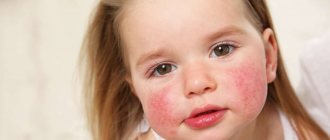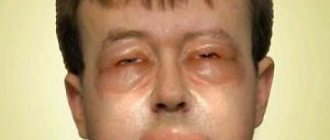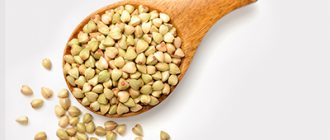Price
Allergology-immunology
| Name of service | Price |
| Consultation with an allergist-immunologist, primary | 3 500 ₽ |
Advantages
- The latest, constantly updated equipment
- Interest-free installments for all services
- Online consultations with an ENT doctor
- Visit of an ENT doctor to your home
- Friendly and qualified staff
- 24/7 ENT assistance
Hives are a condition characterized by a reddish, itchy rash on the skin that is caused by an allergic reaction. It is not contagious and is most often caused by a specific allergen, but in some cases the cause is unknown.
An allergic reaction to hives is fraught with serious complications that require urgent medical attention and are life-threatening. Therefore, you should not endure unpleasant attacks, but contact an allergist and find out how to treat urticaria in your particular case.
Bibliography:
- Russian national consensus document “Urticaria and angioedema: recommendations for practitioners.” Ed. I.S. Gushchina, N.I. Ilyina. M., Farmarus Print Media. 2007, 128 p.
- Jauregui I., Ferrer M., Montoro J. et al. Antihistamines in the treatment of chronic urticaria. J. Investig. Allergol. Clin. Immunol. 2007, v. 17, Suppl. 2, p. 41-52.
- Danilycheva I.V., Ilyina N.I. Quality of life in patients with urticaria and atopic dermatitis. Consilium Medicum. 2001, No. 4, p. 184-186.
- Zuberbier T, Bindslev-Jensen C, Canonica W et al. EAACI/GA,LEN/EDF guideline: management of urticaria. Allergy. 2006, v. 61, p. 321-331.
- Wedi B., Kapp A. Evidence-based therapy of chronic urticaria. J. Dtsch. Dermatol. Ges. 2007, v. 5, p. 146-157.
- Kozel MM, Sabroe R. Chronic Urticaria: etiology, management and current and future treatment options. Drug. 2004, v. 64 (22), p. 2516-2536.
- Fedoskova T.G. The use of cetirizine (cetrin) in the treatment of patients with year-round allergic rhinitis. Ross. Allergol. Journal 2006, no. 5, p. 37-41.
- Grant JA, Danielson L., Rihox JP, De Vos C. A double-blind, single dose, crossover comparison of cetirizine, ebastine, epinastine, fexofenadine, terfenadine, and loratadine versus placebo: suppression of histamine-induced wheal and fl are response for 24 h in healthy male subjects. Allergy. 1999, v. 54, p. 700-707.
- Tataurshchikova N.S. Modern aspects of the use of antihistamines. Children's and adolescent rehabilitation. 2011, no. 2, p. 66-71.
- Tataurshchikova N.S. Modern aspects of the use of antihistamines in the practice of a general practitioner. Pharmateka. 2011, no. 11, p. 46-50.
- Gushchin I.S. Potential of antiallergic activity and clinical effectiveness of II 1 antagonists. Allergology. 2003, No. 1, p. 8-12.
- Petrov V.I., Smolenov I.V., Lopatin A.S. et al. Optimization of pharmacotherapy for seasonal allergic rhinitis in children from a cost/effectiveness perspective. Ross. rhinol. 2002, No. 4, p. 19-22.
- Nekrasova E.E., Razvalyaeva A.V., Vergeichik E.N. et al. Comparative assessment of the biopharmaceutical characteristics of cetirizine in dosage form from different manufacturers. Astrakhan honey. magazine 2010, No. 4, p. 51-55.
- Bezugly P.A., Bolotov V.V., Gritsenko I.S. et al. From substance to medicine. Ed. V.P. Black. Kharkiv. "NFU Golden Pages". 2005, 1244 p.
Causes of urticaria
The cause of allergic urticaria is a malfunction of the immune system. In allergic urticaria, the body reacts to an objectively neutral substance (allergen) as if it were harmful and releases a protein called histamine. When histamine is released, the tiny blood vessels on the surface of the skin (capillaries) become inflamed. Fluid accumulates underneath them, causing blisters.
Why allergies occur with urticaria (substances and provoking conditions):
- medications, including some antibiotics and non-steroidal anti-inflammatory drugs (including aspirin);
- foods that are known to cause histamine production (spinach, fish, yogurt, tomatoes, meat, chocolate, nuts, shellfish, eggs, strawberries);
- alcohol abuse;
- infections including influenza, colds, mononucleosis and hepatitis;
- intestinal parasites;
- sudden change in air temperature;
- high body temperature;
- pet hair;
- dust mites;
- insects;
- latex;
- pollen;
- some chemicals;
- thyroid diseases;
- lupus;
- exposure to sunlight;
- severe stress.
In some cases, doctors do not find the exact cause of the allergy in the form of hives.
For what indications is specialist consultation necessary?
Consultation with an allergist is necessary in case of exacerbation of chronic recurrent urticaria, as well as in intermittent acute form of the disease. The causes of diseases associated with urticaria can be determined by an allergist. It is also necessary to consult a dermatologist, rheumatologist, parasitologist, endocrinologist and, possibly, an oncologist.
Brief description of some clinical forms of urticaria
Allergic urticaria
- Most often acute or episodic
- The most common allergens are food, medications, insect poison, latex
- Patients also have other manifestations of allergy pathology, allergic heredity
- Positive results of allergological examination
- Elimination measures are effective
Autoimmune urticaria
- Current type of chronic idiopathic urticaria
- Frequent presence of autoimmune thyroiditis and thyroid diseases in the family
- Severe general symptoms (weakness, malaise, gastrointestinal dysfunction)
- Presence of histamine-releasing anti-Fcε-RI antibodies and anti-IgE antibodies
- Positive test with autoserum
Cold urticaria
- It can be acquired (idiopathic and arising against the background of an underlying disease, for example, viral hepatitis, lymphoproliferative disease, etc.) and congenital.
- The appearance of itching, burning, hyperemia, urticarial rash, angioedema in areas of the skin exposed to low temperatures
- Symptoms persist for 20-30 minutes and disappear without a trace after the patient warms up
- exposed
Delayed pressure urticaria
- Characterized by the appearance of swelling and blisters in pressure areas 4-6 hours after exposure.
- Characterized by resistance to treatment
Heat urticaria
- Occurs from exposure to heat.
- Hereditary local thermal urticaria has been described, characterized by a delayed (4-6 hours) appearance of elements after local thermal exposure.
- May be accompanied by systemic circulatory disorders and convulsions
Solar urticaria
- Occurs under the influence of ultraviolet radiation
- Blisters appear on exposed areas of the body after exposure to the sun; there may be fixed light urticaria
- The disease can be primary (idiopathic photic urticaria) and
- Secondary light urticaria may be associated with the action of drugs (tetracyclines, sulfonamides, quinolones) or associated with an underlying disease (SLE, thyroiditis, gastrointestinal dysfunction).
Dermographic urticaria
- The appearance of blisters due to mechanical irritation of the skin
- Itching precedes the appearance of rashes
- The phenomenon of dermographism is reproduced by intense line irritation of the skin with a blunt object (spatula)
Vibration urticaria/angioedema
- There are hereditary (autosmal dominant type) and acquired forms
- Characterized by the appearance of a rash and swelling in areas exposed to vibration
- Rash and swelling appear 4-6 hours after exposure to vibration and persist for up to 24 hours.
- The disease is caused by nonspecific degranulation of mast cells
Aquagenic urticaria
- The rash occurs only after contact with water of any temperature
- A rash with severe itching occurs immediately after contact with water
- Characterized by the appearance of small blisters surrounded by erythematous spots
Cholinergic urticaria
- Occurs more often in young people
- Characterized by the appearance of pale pink blisters with a diameter of 1-5 mm, often surrounded by erythema, the rash is generalized
- Provocative factors include exercise, stress, sweating, and hot showers.
- May be accompanied by systemic manifestations (hot flashes, weakness, rapid heartbeat, headache, abdominal pain, shortness of breath
- Can be reproduced by subcutaneous administration of acetylcholine
Adrenergic urticaria
- Rarely seen
- Characterized by the appearance of small papules with a white halo
- Triggered by stress
- Can be reproduced by intradermal injection of epinephrine
Anaphylaxis/urticaria caused by physical exertion
- Characterized by the appearance of skin itching, rashes, angioedema during or immediately after physical activity
- May be accompanied by systemic manifestations, including bronchospasm, laryngeal edema, vascular collapse
- A provoking factor may be the consumption of certain foods (alcohol, apples, shrimp, tomatoes, nuts, celery) before physical activity.
Symptoms of urticaria
With hives, itchy blisters appear on the body - pink or red, oval or round in shape. They can vary from a few millimeters to several centimeters in size. Hives blisters usually appear in batches, often on the face and extremities (urticaria on the arms and legs). Allergic urticaria may appear on only one part of the body, or the rash may cover most of the body.
The blisters usually disappear on their own within 24 hours, but new ones may form afterwards. In some cases, hives may remain on the skin for several days. For people with chronic urticaria, symptoms of allergic urticaria may last for months or years.
In some cases, it is recommended to call an ambulance, as serious complications of allergies due to urticaria are possible - anaphylaxis, Quincke's edema, myocarditis.
Dangerous symptoms, in addition to allergy manifestations of urticaria on the body:
- chills,
- elevated temperature,
- abdominal pain,
- nausea, vomiting,
- cardiopalmus,
- swelling of the mucous membrane of the mouth, tongue, lips,
- weakness and dizziness.
Inspection
If a patient comes to an appointment with a rash, then it is necessary to understand how similar what he sees is to a urticarial rash. The presence of elements other than a blister, as well as atypical secondary elements - crusting, erosion, persistent hyperpigmentation - casts doubt on the diagnosis.
Also, during the examination, you should pay attention to the signs of atopic diseases and other somatic pathologies. If you suspect a connection between physical factors and the development of urticaria, provocative tests are informative. The doctor can apply streak stimulation with a spatula, apply heated or cooled objects, apply vibration sources, irradiate with light of different wavelengths, offer physical exercises and hang weights from the patient’s limbs, followed by assessment of the skin.
Types of allergic urticaria
Hives can be acute or chronic.
Acute allergy with urticaria is the most common type. Symptoms last less than 6 weeks and usually occur in allergic urticaria on the face and neck, fingers and toes. In the acute type, the allergen is usually immediately clear.
Chronic urticaria in adults lasts more than 6 weeks. Most often, it is an idiopathic form of urticaria of unknown origin that can last for months or years. On the skin, allergies with this type of urticaria occur in completely different places.
Forms and complications of urticaria
Urticaria is divided into acute and chronic.
Diagnosis of these forms is based only on the duration of continuous rashes. The limit is 6 weeks of rash.
Acute urticaria , as a rule, does not require any special examinations, with the exception of suspected allergies. In this case, allergy testing with the suspected allergen (eg food) may be required. Most often, acute urticaria is provoked by infections such as ARVI.
If the rash does not stop within 6 weeks, the development of chronic urticaria . Chronic urticaria, in turn, is divided into:
- induced (factors - cold, sun, water or others);
- idiopathic (neither the patient nor the doctor can determine the causes of the rash).
Urticaria or the so-called urticaria-like rash (med. - similar to urticaria) can also be a nonspecific manifestation of some common diseases.
The doctor will help determine the form of the disease and prescribe the necessary examinations and treatment. According to international guidelines (guidelines), numerous and detailed examinations are not carried out for patients with urticaria. If the urticaria is induced, the cause of the rash will be determined at the initial appointment. In most cases, urticaria is idiopathic—it is not caused by diet or lifestyle.
Hives can be one of the manifestations of severe allergic reactions.
In these cases, it occurs simultaneously with symptoms such as swelling (angioedema), shortness of breath and difficulty breathing (bronchospasm), vomiting, diarrhea, decreased blood pressure, lethargy, weakness - even loss of consciousness. In this situation, emergency medical care is necessary.
Treatment of urticaria
Acute allergic urticaria is treated mainly with antihistamines (cetirizine, fexofenadine). They need to be taken regularly over several weeks. The principle of their action is to block the action of histamines, due to which the rash is reduced and the itching of allergies in urticaria stops. Some antihistamines cause drowsiness. Some of them are not suitable during pregnancy unless prescribed by a doctor. Such drugs should not be self-prescribed for allergic urticaria in any case.
The chronic form causes long-term discomfort, and in this case, the symptoms of urticaria are treated. Antibiotics may be prescribed to reduce redness, swelling and other symptoms if the cause is identified.
Physiotherapy provides good help for allergic urticaria.
At the Ear, Nose and Throat Clinic we provide effective treatment for urticaria in adults and children - identifying the root cause and prescribing effective therapy, including physiotherapeutic methods.
Classification of the disease
There are two forms of urticaria:
- acute (duration is about 6 weeks),
- chronic (over 6 weeks).
- There are different types of immunological urticaria:
- Urticarial vasculitis.
- Allergic
- Compliment addict.
- Autoimmune.
- Physical is divided into:
- mechanical: vibration, dermographic;
- temperature: thermal or cold contact;
- allergies that develop under the influence of other extraneous factors.
- There are also the following forms of urticaria:
- Contact.
- Aquagenic.
- Adrenergic.
- Idiopathic.
- Urticaria caused by non-IgE-mediated mast cell degranulation.
- Cholinergic.
- Drug-induced urticaria with development mechanisms different from those previously described.
Allergic urticaria: recommendations to avoid
If the allergy trigger for hives is known, patients should avoid exposure to it as much as possible.
If you know that you are susceptible to spontaneous allergy symptoms due to hives, follow these guidelines:
- abstain from alcohol or reduce its consumption;
- do not prescribe any medications for yourself;
- avoid stress as much as possible;
- use anti-allergenic soaps, skin creams and cleansers;
- Avoid foods that trigger the production of histamine (they are listed in the “Causes of urticaria” section).
Seeing a doctor in a timely manner will help maintain your health.
Don't delay treatment, call right now. We work around the clock. tel. (24 hours a day)
Features of the diet for urticaria
Nutrition is a very important part of successfully recovering from the disease. Regardless of the cause of the rash, it is recommended to adhere to a hypoallergenic diet during an exacerbation. Diet principles:
- Complete exclusion of the product that caused the allergic reaction and any food similar in nature.
- Refusal of products containing chemical additives and preservatives, which can aggravate the course of the disease.
- Refusal of products with dyes, even if they are natural.
- Exclusion of generally recognized allergenic products (nuts, seafood, chocolate, honey).
- Food must be balanced and contain the necessary complexes of macro and microelements.
- Avoid alcohol, as it aggravates the symptoms of the disease.
results
During the research work, informed consent was obtained from patients to participate in this research project. In the 1st group, patients used the drug in a daily dose of 20 mg; in the 2nd group, patients with CCI used Nixar
(bilastine) at a daily dose of 40 mg. An increase in the dose of a second generation antihistamine was carried out in accordance with the federal clinical guidelines for the management of patients with urticaria RODVC (2015) in patients of the 2nd group, whose history was marked by resistance to previous therapy.
For an objective assessment of the therapeutic effectiveness of Nixar
(bilastine) in patients with CHI, the dynamics of clinical manifestations of urticaria were observed (the number of morphological elements during the day) using the UAS7 urticaria activity severity scale; the psycho-emotional state of patients, as well as the comfort of treatment, were assessed using the DIQ before treatment, at 5, 10 and 15 -th day.
During observations of patients with CIC, the following results were obtained: changes in the urticaria activity scale (Fig. 1)
Rice.
1. Change in urticaria activity scale UAS 7 when taking Nixar at a dose of 20 mg/day (n=24) and 40 mg/day (n=27). in the group with a daily dose of 20 mg were 30.4, 23.6, 15.2 and 9.4 points ( p
<0.05) before treatment, on days 5, 10 and 15, respectively;
in the group with a daily dose of 40 mg, this indicator was recorded at the level of 31.1, 20.1, 12.1 and 3.6 points ( p
<0.05), respectively, before treatment, on the 5th, 10th and 15th day.
In accordance with the data obtained, in the group with an increased daily dose of the drug Nixar
(bilastine), a decrease in scores on the urticarial activity scale UAS 7 (Urticarial Activity Score) was recorded by 61.8% compared to group 1, where the drug was used at a daily dose of 20 mg.
When analyzing standardized DIQL questionnaires for patients participating in a post-registration clinical trial, the following results were obtained (Fig. 2):
Rice.
2. DIG when taking Nixar at a dose of 20 mg/day (n=24) and 40 mg/day (n=27). in group 1 on days 5, 10 and 15, respectively 18.3, 14.6, 8.4 and 5.3 ( p
<0.05), in group 2 - 19.1, 12.1 , 4.2 and 2.3 (
p
< 0.05).
According to the data obtained, the quality of daily life over time changed more positively in group 2, where the daily dose of the drug Nixar
(bilasin) was 40 mg, which was reflected in a more pronounced change in the DIQI index by 46.6% compared to group 1 .








